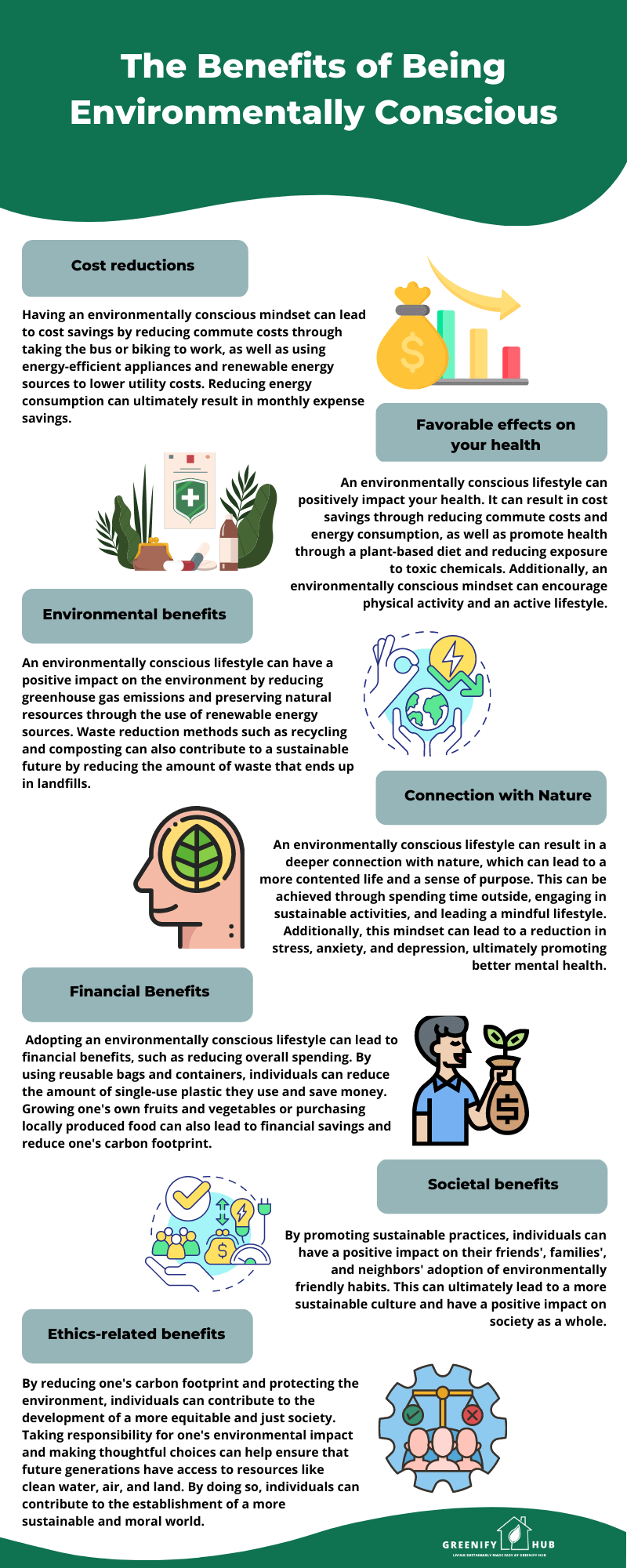Essential Traits of an Environmentally Conscious Individual: Transform Your Impact Today!

What does it mean to be environmentally conscious? It’s more than just recycling or using a reusable water bottle. Environmental consciousness is a way of life, a mindset that prioritizes the health of our planet in every decision we make.
Imagine you’re at a crossroads. One path leads to convenience, the other to sustainability. Which do you choose?
An eco-conscious individual consistently opts for the sustainable path, even when it’s not the easiest option. They understand that every action, no matter how small, has an impact on our environment.
Think about your morning routine. An environmentally conscious person might:
– Choose a bamboo toothbrush over a plastic one
– Opt for package-free shampoo bars
– Use a reusable coffee mug for their morning brew
These small choices add up, reducing waste and minimizing environmental impact.
But it’s not just about personal choices. A truly conscious individual also considers the bigger picture. They might:
– Research a company’s sustainability practices before making a purchase
– Support local businesses to reduce transportation emissions
– Advocate for environmental policies in their community
Environmental consciousness is about understanding the ripple effect of our actions. It’s recognizing that the plastic straw we use today could end up in the ocean tomorrow, harming marine life for years to come.
It’s about seeing the connection between our daily choices and global issues like climate change and deforestation. An eco-conscious person understands that every action, no matter how small, contributes to either the problem or the solution.
Being environmentally conscious isn’t about perfection. It’s about progress. It’s about making better choices whenever we can, and inspiring others to do the same.
Environmental consciousness is a holistic approach to life that prioritizes sustainability in every decision, recognizing the far-reaching impact of our daily choices on the planet’s health.

Three Key Mindsets of an Environmentally Conscious Person
Becoming an eco-warrior isn’t just about actions; it’s about cultivating certain mindsets. Let’s explore three key mindsets that shape an environmentally conscious individual.
Recognizing Interconnectedness Beyond Personal Boundaries
Imagine throwing a pebble into a pond. The ripples spread far beyond the point of impact. This is how an eco-conscious person views their actions.
They understand that using a plastic bag in New York could contribute to a turtle’s death in the Pacific Ocean. They see how driving a gas-guzzling car in London adds to global warming, affecting farmers in Africa.
This mindset of interconnectedness helps them see beyond immediate consequences. They consider:
– How their food choices impact deforestation in the Amazon
– How their energy consumption contributes to climate change
– How their fashion choices affect workers in developing countries
By recognizing these connections, they make more informed, sustainable choices. They understand that every action, no matter how small, is part of a larger ecosystem of cause and effect.
Recognizing interconnectedness means understanding that our actions have far-reaching consequences, influencing global issues like climate change and environmental degradation.
Developing Empathy for Others Affected by Environmental Choices
Empathy is the ability to put yourself in someone else’s shoes. For an eco-conscious person, these “someone elses” include:
– Future generations who will inherit our planet
– Communities affected by pollution and climate change
– Wildlife losing their habitats
Imagine your grandchild asking, “Why didn’t you do more to protect the planet?” This thought motivates eco-conscious individuals to act now.
They consider:
– How their choices affect their local community’s air and water quality
– The impact of their consumption on workers in developing countries
– How their lifestyle contributes to the challenges future generations will face
This empathy drives them to participate in public discourse about environmental issues. They understand that their voice can make a difference in shaping a more sustainable future for all.
Empathy in environmental consciousness means considering how our choices affect others, including future generations and distant communities, motivating more responsible actions.
Desire for Coherence and Willingness to Make Changes
Eco-conscious individuals strive for coherence between their beliefs and actions. They’re not content with talking about sustainability; they want to live it.
This mindset drives them to:
– Regularly assess their lifestyle for areas of improvement
– Embrace change, even when it’s uncomfortable
– Make comprehensive lifestyle choices that align with their values
For example, they might:
– Switch to a plant-based diet
– Choose a job that aligns with their environmental values
– Downsize their living space to reduce their carbon footprint
This willingness to change is crucial for sustainable living. It’s about walking the talk and inspiring others through example.
The desire for coherence drives eco-conscious individuals to align their actions with their beliefs, embracing comprehensive lifestyle changes for sustainability.
Three Key Behaviors of an Eco-Conscious Individual
Eco-conscious individuals don’t just think differently; they act differently too. Let’s explore three key behaviors that define their lifestyle.
Mindful Consumption and Conservation
Imagine going shopping with an eco-warrior. They’d probably bring their own bags, carefully consider each purchase, and opt for products with minimal packaging.
Mindful consumption is about:
– Reducing overall consumption
– Reusing items whenever possible
– Recycling what can’t be reused
For example:
– Instead of buying bottled water, they use a reusable water bottle
– They choose products with recyclable packaging
– They repair items rather than replacing them
Conservation extends to food too. An eco-conscious person might:
– Plan meals to reduce food waste
– Compost kitchen scraps
– Choose locally sourced, seasonal produce
By being mindful of what they consume and how they dispose of it, eco-conscious individuals significantly reduce their environmental impact.
Mindful consumption and conservation involve reducing overall consumption, reusing items, and recycling, extending to all aspects of life including food choices and waste management.
Sustainable Investment and Growth
Eco-conscious individuals understand that their money has power. They invest in a sustainable future, both personally and financially.
On a personal level, they might:
– Install solar panels on their home
– Upgrade to energy-efficient appliances
– Invest in a high-quality, long-lasting wardrobe
Financially, they could:
– Choose banks that don’t invest in fossil fuels
– Invest in renewable energy companies
– Support crowdfunding campaigns for eco-friendly innovations
They see these investments as growth opportunities. By supporting sustainable technologies and businesses, they’re helping to shape a greener economy.
For example, investing in solar power not only reduces their personal carbon footprint but also supports the growth of the renewable energy sector.
This behavior extends to their career choices too. Many eco-conscious individuals seek jobs in sustainability or push for more sustainable practices in their current workplaces.
Sustainable investment involves using personal and financial resources to support eco-friendly technologies, businesses, and practices, contributing to a greener economy.
Effective Advocacy and Education
Eco-conscious individuals don’t keep their knowledge to themselves. They become advocates for the environment, using various platforms to educate and inspire others.
They might:
– Share environmental news and tips on social media
– Participate in local environmental protection initiatives
– Educate friends and family about sustainable practices
For example, they could start a blog about their zero-waste journey or organize community clean-up events.
They understand that collective action is crucial for significant change. By spreading awareness and encouraging others to adopt eco-friendly habits, they amplify their impact.
Effective advocacy involves actively sharing environmental knowledge and inspiring others to adopt sustainable practices, recognizing the power of collective action.
Reducing Your Carbon Footprint
Imagine your carbon footprint as a trail of balloons following you everywhere. Each balloon represents the carbon dioxide and other greenhouse gases released due to your lifestyle choices. The goal? Popping as many of these balloons as possible.
Reducing your carbon footprint is a crucial step in becoming eco-conscious. But where do you start?
Sustainable Transportation Choices
Transportation is often the biggest contributor to personal carbon emissions. Here’s how you can shrink this portion of your footprint:
– Embrace public transportation: A bus full of people emits far less per person than individual cars
– Consider cycling or walking for short trips: Zero emissions and great for your health!
– If you need a car, consider an electric or hybrid model
– For longer journeys, opt for trains over planes when possible
Remember, every mile not driven in a gas-powered car is a balloon popped in your carbon trail.
Opting for sustainable transportation methods like public transit, cycling, or electric vehicles significantly reduces personal carbon emissions.
Energy-Efficient Practices at Home
Your home is another major source of carbon emissions. Here’s how to make it more energy-efficient:
1. Upgrade your lighting:
– Replace traditional incandescent bulbs with LEDs
– Install motion sensors for outdoor lighting
2. Improve insulation:
– Seal drafts around windows and doors
– Add insulation to your attic or walls
3. Use energy-efficient appliances:
– Look for the ENERGY STAR label when purchasing new appliances
– Consider a smart thermostat to optimize heating and cooling
4. Harness renewable energy:
– Install solar panels if possible
– Switch to a renewable energy provider
5. Be mindful of daily habits:
– Turn off lights and unplug devices when not in use
– Use cold water for laundry when possible
– Air-dry clothes instead of using a dryer
These energy-based home improvements not only reduce your carbon footprint but often lead to significant savings on your energy bills. It’s a win-win for your wallet and the planet!
Remember, every kilowatt-hour of energy saved is another balloon popped in your carbon trail. Small changes in daily habits can add up to substantial reductions in your overall carbon footprint.
Implementing energy-efficient practices at home, from upgrading appliances to mindful daily habits, can significantly reduce energy consumption and carbon emissions.
Conserving Resources in Daily Life
Conserving resources isn’t just about turning off the tap while brushing your teeth (although that’s a great start!). It’s about reimagining our daily lives to use resources more efficiently and create less waste.
Minimizing Energy and Water Usage
Every drop of water and watt of electricity saved counts. Here are some ways to minimize your resource use:
1. Water conservation:
– Install low-flow showerheads and faucet aerators
– Fix leaky pipes promptly
– Collect rainwater for gardening
2. Energy efficiency:
– Use a heat pump instead of a traditional HVAC system
– Opt for a solar-powered water heater
– Choose energy-efficient appliances, like ENERGY STAR certified washing machines
3. Smart habits:
– Run full loads in dishwashers and washing machines
– Use cold water for laundry when possible
– Unplug electronics when not in use
Remember, conserving resources isn’t just about what you use, but also about what you don’t use. Every time you choose not to waste, you’re making a positive impact.
Minimizing energy and water usage through efficient appliances and mindful habits significantly contributes to resource conservation in daily life.
Recycling and Avoiding Single-Use Products
The mantra “Reduce, Reuse, Recycle” isn’t just a catchy phrase—it’s a roadmap to a more sustainable lifestyle. Here’s how to put it into practice:
1. Reduce:
– Say no to unnecessary purchases
– Opt for products with minimal packaging
– Choose quality items that last longer
2. Reuse:
– Bring your own shopping bags, water bottles, and coffee cups
– Repurpose glass jars for storage
– Donate items you no longer need instead of throwing them away
3. Recycle:
– Learn your local recycling guidelines
– Set up a multi-compartment recycling bin at home
– Properly dispose of electronics and batteries
Avoiding single-use products is crucial. The environmental impact of a disposable plastic good often far outweighs its brief usefulness. For example, a plastic straw used for 15 minutes can take up to 200 years to decompose!
Instead, seek out better alternatives:
– Use a bamboo toothbrush instead of a plastic one
– Opt for beeswax wraps instead of plastic cling film
– Choose a metal razor over disposable plastic ones
Remember, the most sustainable product is often the one you already own. Before buying something new, ask yourself if you really need it or if there’s a reusable alternative.
Implementing the “Reduce, Reuse, Recycle” principle and avoiding single-use products significantly reduces waste and conserves resources in our daily lives.
Sustainable Eating Habits
Our food choices have a massive impact on the environment. From farm to fork, every bite we take has an environmental cost. Let’s explore how we can make our eating habits more sustainable.
Reducing Meat Consumption
Meat production, especially beef, is a significant contributor to greenhouse gas emissions. Here’s why reducing meat consumption can lead to a better world:
– It reduces deforestation for grazing land
– It decreases water usage in agriculture
– It lowers methane emissions from livestock
You don’t have to go fully vegetarian to make a difference. Try these steps:
1. Start with Meatless Mondays
2. Experiment with plant-based proteins like lentils, beans, and tofu
3. When you do eat meat, choose chicken or fish over beef
4. Reduce portion sizes of meat in your meals
Remember, every plant-based meal you choose is a win for the environment. It’s not about perfection, but progress.
Reducing meat consumption, particularly beef, significantly decreases the environmental impact of our diets by lowering greenhouse gas emissions and resource use.
Shopping for Local and Seasonal Produce
Next time you’re at the grocery store, take a moment to check where your fruits and vegetables come from. Opting for local and seasonal produce can make a big difference:
– It reduces transportation emissions
– It supports your local community and economy
– Seasonal produce often requires fewer resources to grow
Here’s how to shop more sustainably:
1. Visit local farmers’ markets
2. Join a Community Supported Agriculture (CSA) program
3. Learn what produce is in season in your area
4. Look for “locally grown” labels at your grocery store
5. Start a small garden or join a community garden
By choosing local and seasonal produce, you’re not just getting fresher, tastier food. You’re also reducing the carbon footprint of your meals and supporting sustainable agriculture in your community.
Choosing local and seasonal produce reduces transportation emissions, supports local communities, and promotes more sustainable agricultural practices.
Eco-Friendly Home Improvements
Your home is your castle, but it doesn’t have to be an energy-guzzling fortress. Whether you live in a modern apartment or an older building, there are always ways to make your living space more eco-friendly.
Renewable Energy Solutions
Harnessing the power of nature is a game-changer for residential energy use. Solar energy is currently the most popular form of alternative energy for homes. Here’s why:
– It significantly reduces or eliminates electricity bills
– It decreases reliance on fossil fuels
– It can increase your home’s value
Installing a solar energy system might seem daunting, but it’s becoming increasingly accessible:
1. Start with a home energy audit to understand your needs
2. Research local solar installers and get multiple quotes
3. Look into government incentives and tax breaks for solar installation
4. Consider community solar projects if individual installation isn’t feasible
Remember, even if you can’t go fully solar, every bit helps. You could start with solar-powered outdoor lighting or a solar water heater.
Implementing renewable energy solutions, particularly solar power, can significantly reduce residential energy use and reliance on fossil fuels.
Energy Efficient Home Appliances
When it comes to reducing your carbon footprint at home, your choice of appliances plays a crucial role. Energy-efficient appliances not only help the environment but also save you money in the long run. Here’s why investing in energy-efficient home appliances is a smart move:
– They consume less energy, reducing your electricity bills
– They produce fewer greenhouse gas emissions
– They often come with eco-friendly features like water-saving options
Upgrading your appliances to energy-efficient models doesn’t have to happen all at once. You can start by prioritizing the appliances that consume the most energy, such as refrigerators, washing machines, and air conditioners. Look for the ENERGY STAR label when shopping for new appliances, as it indicates high energy efficiency standards.
Here are some tips to make your appliance usage even more sustainable:
1. Use cold water for laundry whenever possible
2. Opt for air drying dishes instead of using the dishwasher’s drying feature
3. Regularly clean and maintain appliances to ensure optimal efficiency
4. Consider smart appliances that allow for energy-saving features and remote control
By making small changes and upgrading to energy-efficient appliances over time, you can significantly reduce your household’s energy consumption and environmental impact. Remember, every conscious choice contributes to a more sustainable future for our planet.
Investing in energy-efficient home appliances not only saves you money but also reduces energy consumption and greenhouse gas emissions, promoting a more sustainable lifestyle.
Conclusion
As we wrap up our journey through the essential traits of an environmentally conscious individual, it’s clear that each of us has the power to make a significant impact on our planet. By embracing interconnectedness, practicing empathy, and striving for coherence in our actions, we can transform our daily lives and inspire others to do the same. From mindful consumption to sustainable investments and effective advocacy, every choice we make ripples outward, contributing to a better world for future generations.
Remember, becoming an eco-warrior is a continuous process of learning and adaptation. Start small, but dream big. Whether it’s reducing your carbon footprint, conserving resources, or advocating for environmental protection, each step you take is crucial. As you implement these eco-friendly practices in your home, workplace, and community, you’ll not only reduce your environmental impact but also experience the profound satisfaction of living in harmony with our planet.
Thank you for reading our article. Together, we can create a sustainable future that we can all be proud of. Let’s embrace this lifelong commitment to sustainability and inspire others through our example. The time to act is now – your choices today shape our tomorrow.





